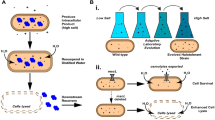Abstract
In the standard method of transformation of Escherichia coli with extraneous DNA, cells are made competent for DNA uptake by incubating in ice-cold 100 mM CaCl2. Analysis of the whole protein profile of CaCl2-treated E. coli cells by the techniques of one- and two-dimensional gel electrophoresis, MALDI-MS and immunoprecipitation revealed overproduction of outer membrane proteins OmpC, OmpA and heat-shock protein GroEL. In parity, transformation efficiency of E. coli ompC mutant by plasmid pUC19 DNA was found to be about 40 % lower than that of the wild type strain. Moreover, in E. coli cells containing groEL-bearing plasmid, induction of GroEL caused simultaneous overproduction of OmpC. On the other hand, less OmpC was synthesized in E. coli groEL mutant compared to its wild type counterpart, by CaCl2-shock. From these results it can be suggested that in the process of CaCl2-mediated generation of competence, the heat-shock chaperone GroEL has specific role in DNA entry into the cell, possibly through the overproduced OmpC and OmpA porins.






Similar content being viewed by others
Abbreviations
- E. coli :
-
Escherichia coli
- MALDI-MS:
-
Matrix assisted laser desorption ionization-mass spectroscopy
- OmpA/C:
-
Outer membrane protein A/C
- Da/kDa:
-
Dalton/kilo Dalton
- MOPS:
-
3-(N-morpholino)propanesulfonic acid
- OD:
-
Optical density
- SDS:
-
Sodium dodecyl sulphate
- DTT:
-
Dithiothreitol
- TOF:
-
Time of flight
- GPS:
-
Global Protein Server
- IEF:
-
Isoelectric focusing
- Wt :
-
Wild type
- μCi:
-
Micro Currie
- ng:
-
Nano gram
References
Addison CJ, Chu SH, Reusch RN (2004) Biotechniques 37:376–382
Aich P, Chatterjee AK, Patra M, Basu T (2011) Int J Genet Mol Biol 3:51–54
Alder GM, Austen BM, Bashford CL, Mehlert T, Pasternak CA (1990) Biosci Rep 10:509–518
Alphen WV, Lugtenberg B (1977) J Bacteriol 131:623–630
Baba T, Ara T, Hasegawa M, Takai Y, Okumura Y, Baba M, Datsenko KA, Tomita M, Wanner BL, Mori H (2006) Mol Syst Biol 2:1–11
Bradford MM (1976) Anal Biochem 72:248–254
Brass JM, Ehmann U, Bukau B (1983) J Bacteriol 155:97–106
Bukau B, Brass JM, Booos W (1985) J Bacteriol 163:61–68
Etchuuya R, Ito M, Kitano S, Shigi F, Soboue R, Maeda S (2011) PLoS ONE 6(1):e16355
Finkel SE, Kolter R (2001) J Bacteriol 183:6288–6293
Huang R (1995) Reusch RN. J Bacteriol 177:486–490
Machida S, Yu Y, Singh SP, Kim JD, Hayashi K, Kawata Y (1998) FEMS Microbiol Lett 159:41–46
MacLachian PR, Sanderson KE (1985) J Bacteriol 161:442–445
Mandel M, Higa A (1970) J Mol Biol 53:159–162
Michod RM, Wojciechowski M, Hoelzer M (1988) Genetics 118:31–39
Misra R, Benson SA (1988) J Bacteriol 170:3611–3617
Oliver BD, Beckwith J (1982) Cell 30:311–319
Panja S, Aich P, Jana B, Basu T (2008) Mol Membr Biol 25:411–422
Panja S, Saha S, Jana B, Basu T (2006) J Biotechnol 127:14–20
Redfield RJ (1988) Genetics 119:213–221
Reusch RN, Huang R, Bramble LL (1995) Biophys J 69:754–766
Reusch RN, Sadoff HL (1983) J Bacteriol 156:778–788
Sabelnikov AG, Domaradsky JV (1981) J Bacteriol 146:435–443
Sambrook J, Rusell DW (2001) In: Sambrook J, Rusell DW (eds) Molecular cloning, vol 1, 3rd edn. Cold Spring Harbor Laboratory Press, New York, p 3.12
Sambrook J, Rusell DW (2001) In: Sambrook J, Rusell DW (eds) Molecular cloning, vol 1, 3rd edn. Cold Spring Harbor Laboratory Press, New York, p 5.4
Sambrook J, Rusell DW (2001) In: Sambrook J, Rusell DW (eds) Molecular cloning, vol 3, 3rd edn. Cold Spring Harbor Laboratory Press, New York, p A3.3
Sambrook J, Rusell DW (2001) In: Sambrook J, Rusell DW (eds) Molecular cloning, vol 3, 3rd edn. Cold Spring Harbor Laboratory Press, New York, p A8.46
Tebbe A, Klein C, Bisle B, Siedler F, Scheffer B, Garcia-Rizo C, Wolfertz J, Hickmann V, Pfeiffer F, Oesterhelt D (2005) Proteomics 5:168–179
VanBogelen RA, Neidhardt FC (1999) In: Link AJ (ed) 2-D proteome analysis protocols: methods in molecular biology, vol 112. Humana Press, NJ
Welte W, Nestel U, Wacker T, Diederichs K (1995) Kidney Int 48:930–940
Acknowledgment
We acknowledge Coli Genetic Stock Centre, Yale University, USA for sending us the strains JW4103 and BW25113. We are grateful to Dr. J. H. Lakey of The University of Newcastle for his kind gift of the strains RAM 363 and RAM 105, Dr. Sekhar C. Mande of Centre for DNA Fingerprinting and Diagnostics, Hyderabad, India for his generous gift of the plasmid pKY206, Dr. Rukhsana Chowdhury and Mr. Sandeep Chakraborty of IICB, Kolkata for analyzing samples in their proteomics facility. We are indebted to the Department of Science and Technology, Govt. of India for the financial assistance (Project No. SR/SO/BB-51/2006) and also for its ‘FIST Programme – 2001-2011’ & PURSE Programme – 2012-15, going on in our department/university to provide different instrumental and infrastructural support.
Author information
Authors and Affiliations
Corresponding author
Rights and permissions
About this article
Cite this article
Aich, P., Patra, M., Chatterjee, A.K. et al. Calcium Chloride Made E. coli Competent for Uptake of Extraneous DNA Through Overproduction of OmpC Protein. Protein J 31, 366–373 (2012). https://doi.org/10.1007/s10930-012-9411-z
Published:
Issue Date:
DOI: https://doi.org/10.1007/s10930-012-9411-z




